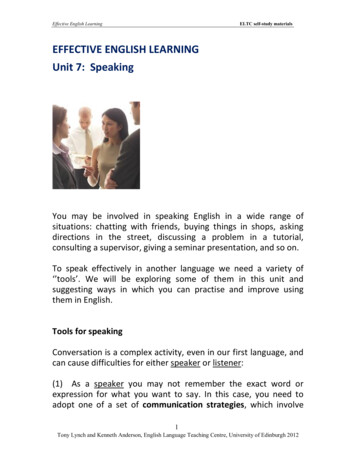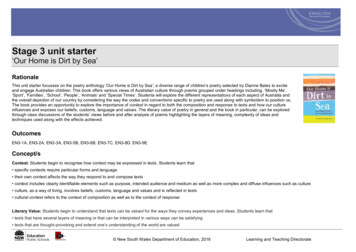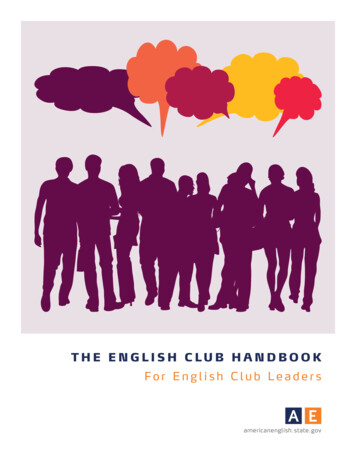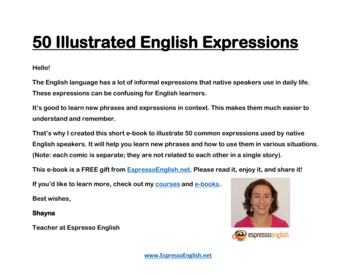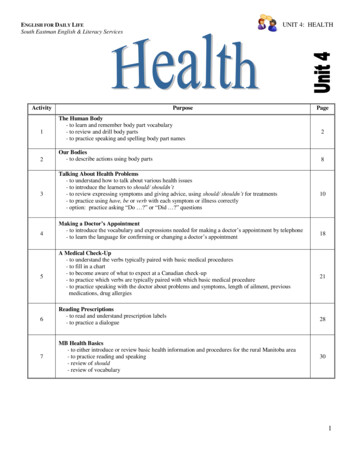
Transcription
UNIT 4: HEALTHENGLISH FOR DAILY LIFESouth Eastman English & Literacy ServicesActivity1234567PurposeThe Human Body- to learn and remember body part vocabulary- to review and drill body parts- to practice speaking and spelling body part namesOur Bodies- to describe actions using body partsTalking About Health Problems- to understand how to talk about various health issues- to introduce the learners to should/ shouldn’t- to review expressing symptoms and giving advice, using should/ shouldn’t for treatments- to practice using have, be or verb with each symptom or illness correctly- option: practice asking “Do ?” or “Did ?” questionsMaking a Doctor’s Appointment- to introduce the vocabulary and expressions needed for making a doctor‟s appointment by telephone- to learn the language for confirming or changing a doctor‟s appointmentA Medical Check-Up- to understand the verbs typically paired with basic medical procedures- to fill in a chart- to become aware of what to expect at a Canadian check-up- to practice which verbs are typically paired with which basic medical procedure- to practice speaking with the doctor about problems and symptoms, length of ailment, previousmedications, drug allergiesReading Prescriptions- to read and understand prescription labels- to practice a dialogueMB Health Basics- to either introduce or review basic health information and procedures for the rural Manitoba area- to practice reading and speaking- review of should- review of vocabularyPage2810182128301
UNIT 4: HEALTHENGLISH FOR DAILY LIFESouth Eastman English & Literacy Services1. The Human BodyActivity 1Purpose:- to learn andremember body partvocabulary- to review and drillbody parts- to practice speakingand spelling bodypart namesCLB Level:2/3Time:50 - 60 minutesMaterials:- a Human Bodyworksheet for eachlearner- one set of Draw andGuess cards to beused for a whole classactivity- Crossword PuzzlesA and B for each pairof learnersInstructions:1. Present the vocabulary for the human body on the board,including all basic exterior parts and some basic interior organs.In order to present this, the teacher could draw a picture of ahuman body on the board and fill it in together with thestudents, getting an idea of the learners‟ prior knowledge.2. Hand out the Human Body worksheet to each learner and havethe learners label the body diagram, reinforcing and practicingthe vocabulary they just learned. Check the answers together asa class.Answer Key:1) hair6) nose11) heart16) stomach21) thigh26) toe2) eyebrow7) neck12) lung17) kidney22) knee3) ear8) mouth13) arm18) bladder23) leg4) eye9) throat14) liver19) hand24) ankle5) head10) shoulder15) elbow20) fingers25) foot3. Prepare the Draw and Guess cards for this next game. Dividethe class into 2 teams. Write Team 1 at the top of one side ofthe board and Team 2 at the top of the other. Keep track ofpoints here.4. The teacher chooses one card from the Draw and Guess cards.One player from each team comes to the board, is shown theword on the card, and draws what is on the card. Each teamwill watch what the two players are drawing and guess what isdrawn. The first player to guess correctly wins a point for his /her team. Continue playing until the cards run out or untileveryone has had a chance to draw.5. Divide the class into two groups, A and B. Hand out CrosswordA to Group A and Crossword B to Group B. Have learner A sitacross from learner B to ensure they cannot read each otherssheet.6. Each learner will take turns reading a clue to fill in the missinginformation on his/her puzzle.To keep this more controlled the following dialogue can bewritten on the board:2
UNIT 4: HEALTHENGLISH FOR DAILY LIFESouth Eastman English & Literacy ServicesA:B:A:B:What‟s 3 down?There are 5 of these on your hand.Oh! Is it fingers?Yeah. That’s right.Variation: Prior to dividing them into pairs have the A learners fillin the A answers from their clues and the B learners fill in the Banswers from their clues. Once they have finished, place them intopairs to fill in the other half in the same way as above.Answer Key:SS3
UNIT 4: HEALTHENGLISH FOR DAILY LIFESouth Eastman English & Literacy ServicesThe Human headlungthigheyeheartmouthtoe1Human Body worksheet4
UNIT 4: HEALTHENGLISH FOR DAILY LIFESouth Eastman English & Literacy ServicesDraw and Guess toesankleelbowthighknee1Draw and Guess cards5
UNIT 4: HEALTHENGLISH FOR DAILY LIFESouth Eastman English & Literacy ServicesPuzzle A – Across4.you need these to breathe5.this is the top part of your leg6.this is the motor of your body8.this is on your head; you brush it9.you use this to see10.this is a small bone on the side of your foot13.this connects your arm to your neck1Puzzle A worksheet6
UNIT 4: HEALTHENGLISH FOR DAILY LIFESouth Eastman English & Literacy ServicesPuzzle B – Down1.you eat with this2.you walk or run with this3.there are 5 of these on your hand7.there are 5 of these on your foot8.this is under your hair11.this is between your thigh and your calf12.you use this to smell1Puzzle B worksheet7
UNIT 4: HEALTHENGLISH FOR DAILY LIFESouth Eastman English & Literacy Services2. Our BodiesActivity 2Purpose:- to describe actionsusing body partsCLB Level:3Time:20 minutesMaterials:- Our Bodiesworksheet for eachlearnerInstructions:1. Have learners quickly review body parts. Pantomimedifferent motions with body parts (bend your knee,shake your head, etc.) and ask learners what you aredoing?2. Hand out Our Bodies worksheets to learners andintroduce any new verbs with gestures. Have learnersfill in the sentences with the verbs as a class orindividually.3. Review the sentences together, discussing them asyou go through them.8
UNIT 4: HEALTHENGLISH FOR DAILY LIFESouth Eastman English & Literacy ServicesOur Bodies1. Find a verb that tells you what different body parts do. Some verbs can be usedfor more than one body ow8. eyesshoulder9. earsleg10. fingersarm11. nosetongue 12. teethhead13. handmouth14. back2. Fill in the Blanks using verbs from above.Doctor: Can you your knee?Mother: Can you this box downstairs?Boyfriend: I want to your hand.At supper: Doesn‟t this chicken good?Outside: Too bad we can‟t the stars. It‟s socloudy.Child: Don‟t so fast. My legs are too short.Woman: I love the of roses.Father: I can‟t you. My cell phone is cutting out.Co-worker: Don‟t the wires. You might get a shock.Teacher: I‟m sorry, you can‟t gum in class.Photographer: for the camera!Doctor: your knees when you heavy boxes.Mother: Don‟t your shoulders. Answer me. Yes or no.Soccer Coach: When you get the ball, it to the middle.Father: Don‟t so much TV. You‟ll strain your eyes.2Our Bodies9
UNIT 4: HEALTHENGLISH FOR DAILY LIFESouth Eastman English & Literacy Services3. Talking about Health ProblemsActivity 3Purpose:- to understand how totalk about varioushealth issues- to introduce thelearners to should/shouldn’t- to review expressingsymptoms and givingadvice, using should/shouldn’t for treatments- to practice using have,be or verb with eachsymptom or illnesscorrectlyCLB Level:3 Time:An hour and a halfMaterials:- How to ExpressChart for each learner- What Should I DoWorksheet for eachlearner (each pagemakes 2 copies)- one set ofSymptom/TreatmentMatch-Up cards for theclass- a set of Symptomcards for each pair- Doctor, What ShouldI Do worksheet foreach learner- Advice Surveyworksheet for eachlearner- at least 2 sets ofSymptom Flash cardsper class cut upInstructions:1. Hand out a How to Express Chart to each learner.Go through the list with students, explaining each point briefly, butmaking sure everything is understood.2. As a class, ask learners to tell you some common health problemsthat occur in their families and write them on the board. Then, askfor some possible treatments for each. Explain the concept andstructure of should in a sentence, giving an example of this on theboard. Use the examples they‟ve given to demonstrate this structure.Example:I have a cold. You should drink lots of fluids and stay warm.(Subject should basic verb)3. Hand out the What Should I Do worksheet to each learner. Givethe learners 10 minutes or so to match the symptoms and treatments.Then check the answers.Answer Key:1) I have a sore throat.2) I have a toothache.3) I have a stomachache.chf4) I have a backache.5) I am dizzy.6) I have a rash.7) I have a cold.kbij8) I cut my hand.g9) I have an earache.10) I have a headache.ae11) I broke my leg.12) I sprained my ankle.lda) You should use ear drops.b) You should sit down and rest,c) You should gargle with salt and warmwater.d) You should put ice on it.e) You should take an aspirin and rest.f) You shouldn‟t eat anything spicy.g) You should clean it and put a band aidon it.h) You shouldn‟t drink anything too hotor too cold.i) You shouldn‟t scratch it.j) You should drink lots of fluids andstay warm.k) You shouldn‟t lift heavy things.l) You should go to the doctor and get acast.4. Hand out the Symptom/Treatment Match Up cards, one card toeach learner. Ensure that the number of cards given out have apartner card. (The teacher may wish to copy the symptoms cardsonto one color of paper and the treatment cards onto another color asto make it clearer to the learners whom their match may be.)10
ENGLISH FOR DAILY LIFESouth Eastman English & Literacy ServicesUNIT 4: HEALTH5. Have the learners walk around the class reading their card to otherlearners. They are to match the symptom or treatment to their owncard. Once all the learners have found their partner, have them readtheir cards to the whole class.6. In these newly formed pairs, learners are ready for the next activity.Hand out the Doctor, What Should I Do worksheet to eachlearner and a set of Symptom cards to each pair. (In order to givewriting practice, the teacher may opt to copy only the Symptom cardsand just write the dialogue for the Doctor, What should I doworksheet on the board. Students can then copy this dialogue intotheir notes.) Pairs should place the cards face down and take turnspicking one up and practicing the dialogue.7. After they have done this with the dialogue guide for a few rounds,take away the dialogue guide and allow them to try it completely ontheir own.8. Explain how we use should/ shouldn’t to give advice in non-healthrelated situations as well. Brainstorm some examples with learnerson the board. Hand out the Advice Survey worksheet to eachlearner.Have the learners walk around the class and tell their “problem” tovarious learners - a different learner for each question. That learnerthen gives them advice using should / shouldn’t. To show thequestion has been asked, learners should write the advice they weregiven in the second column.11
essedallergic tomentally illmentally disabledphysically disableddiabetichypoglycemicHAVE/HASa headachea stomachachea backachea toothachean earachea sore throata colda runny/stuffy nosea coughan allergypoison ivya rasha soreacnea bruisea cuta burna infectiona broken lega sore/sprained anklea twisted anklehigh blood pressurecrampsa cramp in mya feverthe SdiabetesasthmaAlzheimer’sheart disease(I had/am having) a heart attackepilepsyMy is stiffMy is soreMy is swollenMy is infectedMy is bleedingbroke my armsprained my armtwisted my armgot a bee sting/mosquito bitegot sickcaught a coldgot hit by a carwas in a car accidentfell downslippedtrippedcut myselfpoked myselfMy is killing meMy is throbbingMy is stingingMy is burningMy hurtsMy achesMy is soreMY (BODY PART) SI/YOU/HE/SHE (VERB)How to Express Sickness/Symptoms/ConditionsUNIT 4: HEALTHENGLISH FOR DAILY LIFESouth Eastman English & Literacy Services3How to Express Chart12
UNIT 4: HEALTHENGLISH FOR DAILY LIFESouth Eastman English & Literacy ServicesWHAT SHOULD I DO?1) I have a sore throat.2) I have a toothache.3) I have a stomachache.4) I have a backache.5) I am dizzy.6) I have a rash.7) I have a cold.8) I cut my hand.9) I have an earache.10) I have a headache.11) I broke my leg.12) I sprained my ankle.a) You should use ear drops.b) You should sit down and rest.c) You should gargle with salt and warm water.d) You should put ice on it.e) You should take an aspirin and rest.f) You shouldn‟t eat anything spicy.g) You should clean it and put a band aid on it.h) You shouldn‟t drink anything too hot or too cold.i) You shouldn‟t scratch it.j) You should drink lots of fluids and stay warm.k) You shouldn‟t lift heavy things.l) You should go to the doctor and get a -WHAT SHOULD I DO?1) I have a sore throat.2) I have a toothache.3) I have a stomachache.4) I have a backache.5) I am dizzy.6) I have a rash.7) I have a cold.8) I cut my hand.9) I have an earache.10) I have a headache.11) I broke my leg.12) I sprained my ankle.a) You should use ear drops.b) You should sit down and rest.c) You should gargle with salt and warm water.d) You should put ice on it.e) You should take an aspirin and rest.f) You shouldn‟t eat anything spicy.g) You should clean it and put a band aid on it.h) You shouldn‟t drink anything too hot or too cold.i) You shouldn‟t scratch it.j) You should drink lots of fl
- to introduce the vocabulary and expressions needed for making a doctor‟s appointment by telephone - to learn the language for confirming or changing a doctor‟s appointment 18 5 A Medical Check-Up - to understand the verbs typically paired with basic medical procedures - to fill in a chart - to become aware of what to expect at a Canadian check-up - to practice which verbs are typically .




